Introduction: In this article, Melissa Davenport Berry writes about a controversial monument to the 17th century persecuted Quakers that the town of Salem, Massachusetts, rejected. Melissa is a genealogist who has a blog, AnceStory Archives, and a Facebook group, New England Family Genealogy and History.
When Frederick Fanning Ayer, a wealthy philanthropist, proposed in 1904 to gift the town of Salem, Massachusetts, with a memorial statue to honor his ancestors, the town’s authorities were confronted with a conflict. The subject of the statue represented a period of history many of Salem’s Puritan descendants wanted to forget: the Quaker persecutions, which swept the early colonies in the 17th century.
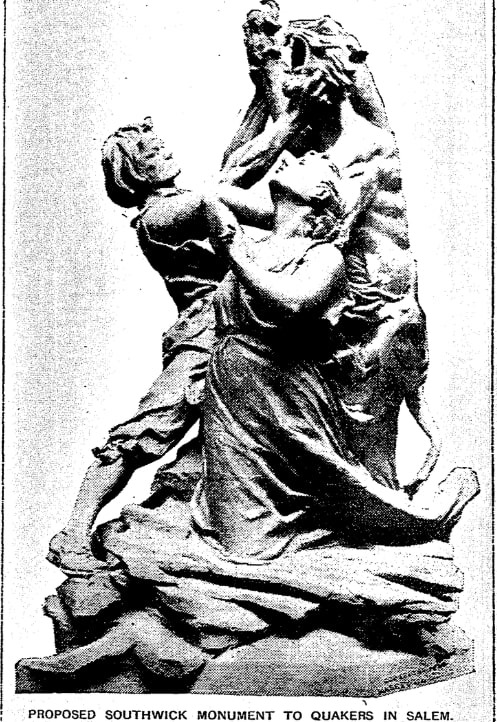
Ayer was a direct descendant of Lawrence and Cassandra Southwick, practicing Quakers who suffered cruel punishments imposed by the Puritan authorities in Salem from 1657 to their deaths in 1660. (A full account from court records will be in my next article.)
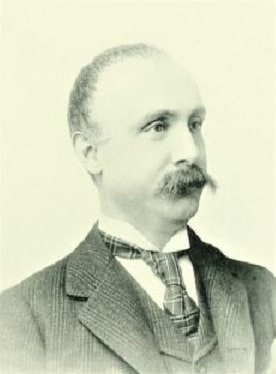
Ayer attended the unveiling of the monument for Nathaniel Sylvester on Shelter Island, N.Y., in 1884. More than two hundred years earlier, Sylvester had offered refuge to persecuted Quakers, and Lawrence and Cassandra Southwick were among them (see: Nathaniel Sylvester, ‘Lord of Shelter’ for 17th Century Quakers).
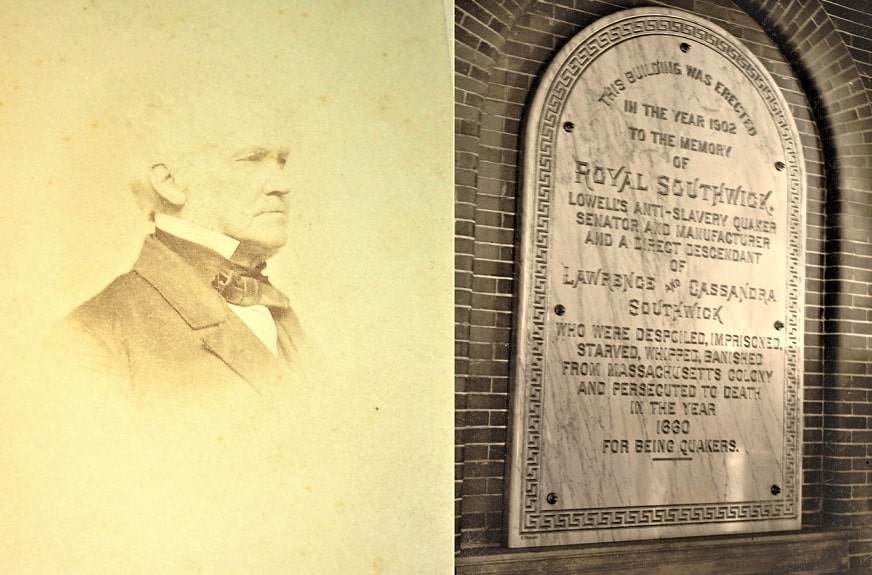
A year before Ayer proposed a monument in Salem, a dedication plaque was placed on Southwick Hall (he had given $100,000 for the construction of the building) at the University of Massachusetts Lowell. The plaque commemorated Ayer’s maternal grandfather and reads:
THIS BUILDING WAS ERECTED
IN THE YEAR 1902
TO THE MEMORY
OF
ROYAL SOUTHWICK,
LOWELL’S ANTI-SLAVERY QUAKER
SENATOR AND MANUFACTURER
AND A DIRECT DESCENDANT
OF
LAWRENCE AND CASSANDRA
SOUTHWICK
WHO WERE DESPOILED, IMPRISONED,
STARVED, WHIPPED, BANISHED
FROM MASSACHUSETTS COLONY
AND PERSECUTED TO DEATH
IN THE YEAR
1660
FOR BEING QUAKERS.
According to the Boston Herald, Ayer commissioned the celebrated sculptor John M. Rhind and instructed him to spare no cost [$50,000]. The design portrayed a man and a woman being attacked by a tiger – but the committee argued the statue was not a work of art and it represented an unpleasant subject.
As the Evening Times-Republican reported, the symbolism of the statue was apparent to all.
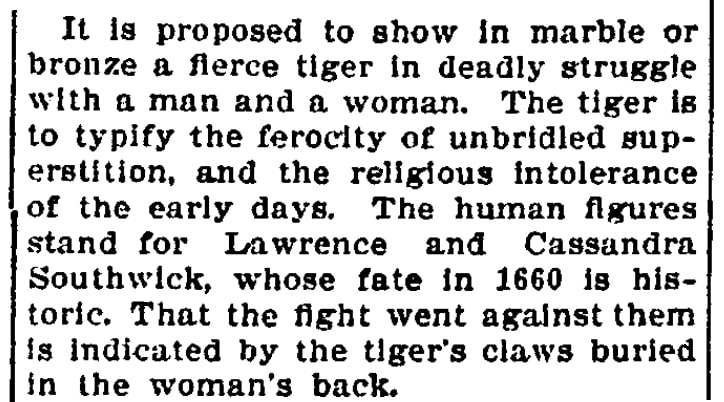
In June, the Boston Herald announced the Salem Council voted 5 to 2 in favor of the statue, but with stipulation that Ayer must agree to certain design changes. Ayer was willing to modify the inscription, but would not alter the statue itself and pressed on with his initial proposal. The town ultimately refused his gift, and the statue was never completed.
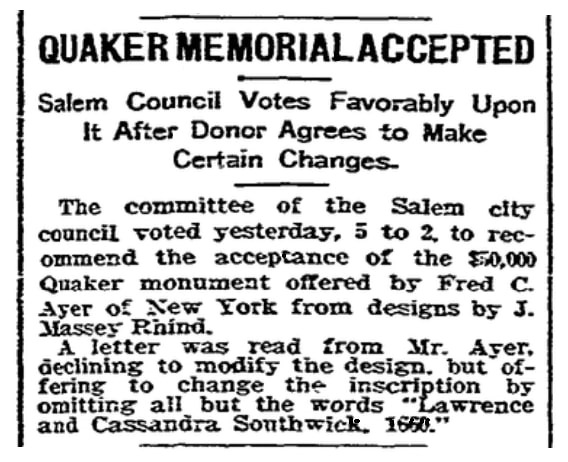
A letter to the editor submitted to the Boston Herald by Rev. Nathan Southwick Hill sums up the rejection behind the proposed statue and echoes the same chilly curse Hawthorne exposed in his writing.
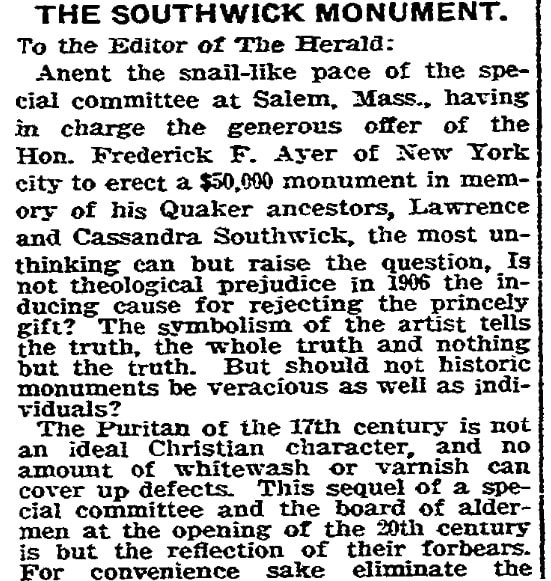
This letter is worth quoting in full:
“Anent [i.e., concerning] the snail-like pace of the special committee at Salem, Mass., having in charge the generous offer of the Hon. Frederick F. Ayer of New York city to erect a $50,000 monument in memory of his Quaker ancestors, Lawrence and Cassandra Southwick, the most unthinking can but raise the question, Is not theological prejudice in 1906 the inducing cause for rejecting the princely gift? The symbolism of the artist tells the truth, the whole truth, and nothing but the truth. But should not historic monuments be veracious as well as individuals?
“The Puritan of the 17th century is not an ideal Christian character, and no amount of whitewash or varnish can cover up defects. This sequel of a special committee and the board of aldermen at the opening of the 20th century is but the reflection of their forbears. For convenience sake eliminate the artistic model and substitute realism.
“Would it be more acceptable to the city fathers to picture Gov. Endicott putting questions to Cassandra Southwick simply to entrap her in the meshes of the law? Or would the sentence of banishment imposed upon Lawrence and Cassandra Southwick: dying of privation and exposure at Shelter Island, N.Y., heighten our appreciation of the persecuting spirit? Turning to their children, can we admire the cruelty wreaked upon their son Josiah, when he was stripped from his girdle upward, tied to a cart’s tail and whipped 10 stripes in each of the towns of Boston, Roxbury, and Dedham? Or, can we commend the General Court of Massachusetts when it ordered two other of their children, Daniel and Provided, to be ‘sold for slaves to any Christian in Virginia or Barbados’? But to the credit of human nature be it reported that no shipmaster was found inhuman enough to carry out the fiendish decree.
“While the projected monument at Salem may be rejected by the unwisdom of a majority vote, yet the muse of [John Greenleaf] Whittier will pass onward the simple, truthful ballad of ‘Cassandra Southwick,’ and time will certainty rectify the ancient wrong. The grim ghosts of witchcraft and the Quaker persecution at Salem dim the glory of the early days, and if nine generations later it is premature to portray the truth in bronze or marble, yet in all charity we fail to commend the hereditary narrow gauge spirit in 1906.”
Genealogy of Ayer/Southwick line:
- Frederick Fanning Ayer
- Josephine Mellen Southwick and Joseph Cook Ayer
- Royal Southwick and Direxa Claflin
- Royal Southwick and Phebe Farnum
- Lawrence Southwick and first cousin Hannah Southwick (d. of Jonathan Southwick and Hannah Osborne)
- Daniel Southwick and Ruth Shove
- Lawrence Southwick and Tamson Buffum
- Daniel Southwick and Esther/Hester Boyce
- Lawrence and Cassandra Southwick
Note: Just as an online collection of newspapers, such as GenealogyBank’s Historical Newspaper Archives, helped tell the stories of Frederick Fanning Ayer and his Quaker ancestors, they can tell you stories about your ancestors that can’t be found anywhere else. Come look today and see what you can discover!
Up next: more about the 17th century Quaker persecutions.
Related Article:

Very interesting and well written!
Ed Mair
Thank you Ed! I know you love your Quaker history. I will have Newbury coming up soon.
Your research and informatin are always great fun to read. I always learn a lot.
Thank you Laurie! Newbury Quakers will be in the mix so stay tuned!
Interesting reading of the persecutions.
George Aldrich and his family left Plymouth Colony rather quickly after the Puritans took control of it. The family were Baptists and pretty much opposed to the Puritans. The family moved to Mendon area which was beyond the reach of the Puritan control. Grandson was Moses Aldrich, the “Quaker Preacher.” My 7th great grand uncle, born 1690, died 1761.
Thank you for sharing David! I just got a book about Quakers and Baptists in colonial Massachusetts, and I bet this Aldrich line is mentioned. Something else to write about! Will keep you posted.
Thanks. As a rarity, I am a double descendant of Lawrence and Cassandra, since a descendant of Daniel and a descendant of Provided, as third cousins, married each other.
Robert, I appreciate your comment! The Southwick-Ayer line is a double as well — Lawrence Southwick married his first cousin Hannah Southwick (d. of Jonathan Southwick and Hannah Osborne). Maybe this is the connection, but I am finding so many intermarriages between the early Quaker families.
Thank you for the wonderful article. I am also a descendant of Cassandra and Lawrence. While researching my ancestry, I discovered the records of the brutal punishments issued to the Quakers in Salem. I was surprised where “religious freedom” was taught in school in our school history that this did not really occur. It is important to have articles that enlighten us to our real history.
Thank you Joan, I so appreciate it. And yes we do need to keep this history alive and noted — or, as in the style of Nathaniel Hawthorne, break the curse and avenge the ancestors. Stay tuned, there will be more Southwick drama.
Stay tuned, there will be more Southwick drama.
There is an error in the letter of Rev. Nathan Southwick Hill. He lists nine generations between “Lawrence and Cassandra Southwick” and “Frederick Fanning Ayer.” He includes both wives of Royal Southwick. Only one of these wives can be the mother of Josephine Mellen Southwick, and therefore, only one generation of Royal Southwick should be counted.
Hi Janice,
I am not sure what you are referring to — the genealogy I listed at the end of the article is correct: There are two Royal Southwick’s listed.
Royal Southwick (1795-1876), father of Josephine. He is the son of Royal Southwick (1760-1840) and Phebe Farnum.
There is also a third Royal (1834-1884), brother of Josephine. This lineage has been well documented.
This is really great! Is there a way to add persons to this monument’s list? I would love to see John Bowne and Hannah Feake Bowne added to this memorial. They are our 10th Gr. Grandparents with connections to Mass.. They were instrumental in the founding of Flushing Friends Meeting. The Bowne House is now open again to the public after restorations. Hannah and John traveled the world promoting the Quaker faith. John was imprisoned for harboring Quakers and holding meetings. He argued for religious freedom in the Netherlands while being held prisoner. This document was the “1657 Flushing Remonstrance,” a precursor to the Bill of Rights and to welcome ALL People to the New Netherlands.
Thank you Frank! I will look into this Bowne line. Sounds very interesting. I just purchased a few more Quaker history books so I am sure they are in there, and I bet GenealogyBank has some info.
When one generation behaves unjustly or cruelly without feeling or expressing regret, it is up to subsequent generations to advance civilization and humanity by recognizing the wrong, behaving better, and seeking ways to make up for the harm. Approving an honest memorial allows subsequent generations to salve the wounds inflicted on their ancestors’ victims almost as effectively as if their ancestors themselves had apologized and resolved to make amends as best as they could. I appreciate the statue of my 9th great grandmother, the Quaker martyr, Mary Dyer, facing Boston Common, where she was hung for challenging the colony’s “bloody law.”
Thank you Robert, and I will be covering Mary Dyer some more. I was just reading about her following the teachings of Anne Hutchinson. Stay tuned and I appreciate your feedback.
My great+ grandmother was related to the Southwicks. I’ve not gotten into this too deeply, only what cousins have sent me.